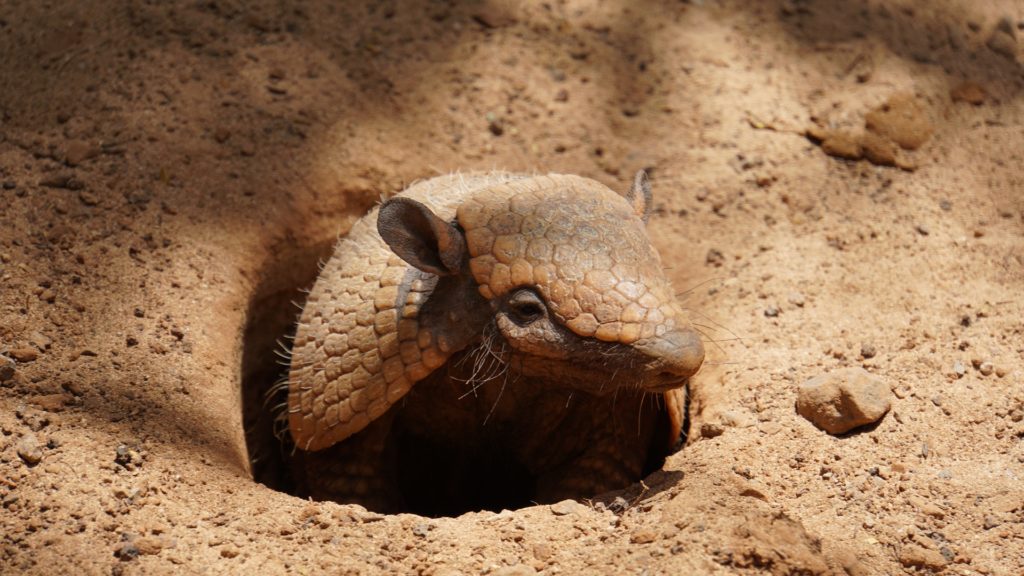How does animal armour work?
by Scott Dutfield · 27/09/2020
Discover how these thick-skinned species protect themselves in the wild

Trying to survive in the wild can be a tough game. Animals don’t always know when danger may leap out at them from the forest or from the air, so having a natural suit of armour can come in handy.
One collection of animals are well-known for their armoured appearance. Arthropods, six-legged invertebrates including insects, crabs and scorpions, strut around in a hardened suit called an exoskeleton for protection. Made from a tough chitin-protein material – or calcium carbonate if you’re a crustacean – this all-encompassing armour does not expand as the animal within it grows, so a new suit needs to be fashioned every time its armour becomes too tight a fit. Replaced in a process known as moulting, when an animal such as a crab has outgrown its exoskeleton it will absorb some calcium carbonate from the old shell to form a new soft one beneath. After releasing an enzyme to detach its old suit, the freshly dressed crab will break away and wait for its new shell to harden, hoping that predators don’t spot it in
the meantime.
Having a fortified natural suit isn’t exclusive to the arthropod world, extending to reptiles such as crocodiles, tortoises, fish species such as the alligator gar and also many mammals.
One of the most iconic armoured mammals is the armadillo. Covering the majority of this small creature are around 2,000 tiny scales, also called scutes, that have erupted from their skin to form a shell-like exterior. Known as the carapace, a term also attributed to the shells of turtles, this tough exterior is made up of the robust protein keratin. However, this suit of armour is not designed as a rigid barrier for physical protection, but has evolved in such a way that the armadillo can curl up to form a protective ball. Growing in three distinct sections, the scapular shield at the front and pelvic shield at the rear sandwich rows of sliding armour in the middle. This telescopic design, similar to that of woodlice, gives the armadillo its ability to curl up. Not all armadillo species can form a complete spherical shield. Seven-banded armadillo, for example, lack the space beneath their shell to tuck all their limbs and head within. The three-banded armadillo, on the other hand, has a scaly suit that transforms it into a biological ball thanks to some extra shell room and shielding on its head and tail.
Armadillos aren’t alone in their preference to curl up into a protective ball; pangolins also form a scaly sphere for safety. Found across Asia and parts of Africa, pangolins defend themselves from large carnivores, such as lions and tigers, with a coat of armour that covers almost their entire body. Made from the same material as an armadillo’s, these keratin scales not only act as a hard defense, but are also designed to redirect any fractures from reaching the soft body below. Due to the humid environment these animals favour, the keratin armour remains hydrated and tough, whereas in a drier climate their scales would be more brittle and susceptible to cracks. Although pangolins might be shielded from other animals, humans pose the biggest threat to their survival. Believed to be the most trafficked animal in the world, more than a million have been taken from the wild and sold for their scales and meat since 2000.
Dressing in a coat of armour doesn’t just protect an animal against the physical attacks of predators, but also helps prevent invasions from parasites. By covering the soft, blood-filled parts of their body, animals such as pangolins and armadillos limit their exposure to blood-sucking parasites and pests. In turn, their risk of picking up a parasite-transmitted disease or infection from a bite is reduced.
Being shielded by a protective layer of thick skin, a hard shell or a series of scales can help prevent the advances of a predator. However, some species use their body armour to go on the offensive. Mammals such as the hedgehog and the egg-laying echidna are armed with thousands of spines to ward away any unwanted visitors. But the king of prickly protection is the porcupine, native to Africa. Armed with sharp quills spanning between 2.5 to 30.5 centimetres long, porcupines are not easy prey. They’re typically seen dashing through woodlands and rocky outcrops, and while moving their quills are flattened to form a spiky tail. When facing off with a predator, porcupines will raise their quills to show they mean business.
These quills essentially grow in the same way our hair grows, in a cycle that results in tough, hollow spines. Quills are often found buried in the chins of animals that have had an encounter with a porcupine, leading to the common misconception that porcupines can fire their quill at will to impale predators. This is not the case: porcupines merely release quills from their bodies once they have punctured the skin of another animal. At the tip of each quill, rows of hooked barbs coat the surface, making them easy to enter the skin but hard to pull back out.
This article was originally published in How It Works issue 133
For more science and technology articles, pick up the latest copy of How It Works from all good retailers or from our website now. If you have a tablet or smartphone, you can also download the digital version onto your iOS or Android device. To make sure you never miss an issue of How It Works magazine, subscribe today!





